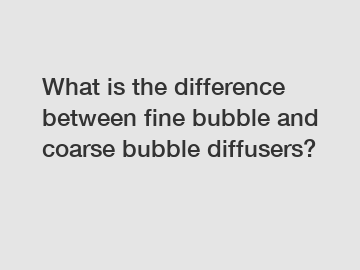Mar. 22, 2024
Agriculture
Fine Bubble vs Coarse Bubble Diffusers: Understanding the Difference.
When it comes to wastewater treatment systems, diffusers play a crucial role in the aeration process. Fine bubble and coarse bubble diffusers are two common types of diffusers used in wastewater treatment plants. While both types serve the same purpose of introducing air into the water, they differ in terms of bubble size, efficiency, and application. In this article, we will explore the differences between fine bubble and coarse bubble diffusers to help you understand which type may be best suited for your wastewater treatment needs.
Fine Bubble Diffusers:

Fine bubble diffusers are designed to produce very small bubbles, typically less than 2 mm in diameter. These tiny bubbles have a large surface area relative to their volume, which allows for efficient transfer of oxygen from the air to the water. The small size of the bubbles also means that they remain in suspension longer, providing more contact time with the water.
One of the key advantages of fine bubble diffusers is their high oxygen transfer efficiency. The large surface area of the bubbles allows for greater oxygen transfer per unit of air used, making them more energy-efficient compared to coarse bubble diffusers. Fine bubble diffusers are also known for producing a more uniform distribution of bubbles, which helps to ensure consistent oxygen levels throughout the water column.
Fine bubble diffusers are typically used in applications where a high level of oxygen transfer is required, such as in activated sludge treatment systems or biological nutrient removal processes. They are also well-suited for applications where aeration needs to be gentle, such as in fish farms or sensitive biological treatment processes.
Coarse Bubble Diffusers:
Coarse bubble diffusers, on the other hand, produce larger bubbles, typically ranging from 2 to 6 mm in diameter. While coarse bubble diffusers have a lower oxygen transfer efficiency compared to fine bubble diffusers, they are better suited for applications where large volumes of air need to be delivered quickly.
Featured content:One of the main advantages of coarse bubble diffusers is their ability to provide effective mixing and circulation in wastewater treatment tanks. The larger bubbles produced by coarse bubble diffusers create turbulence in the water, helping to prevent stratification and promote the mixing of solids. This can be particularly beneficial in applications where solids settling or clogging is a concern.
Coarse bubble diffusers are commonly used in applications such as equalization tanks, sludge digestion tanks, and industrial wastewater treatment systems. They are also well-suited for applications where aeration intensity is not a primary concern, such as in flow equalization or destratification.
Choosing the Right Diffuser for Your Application:
When selecting a diffuser for your wastewater treatment system, it is essential to consider factors such as oxygen transfer efficiency, aeration intensity, and mixing requirements. Fine bubble diffusers are ideal for applications where high oxygen transfer efficiency and gentle aeration are needed, while coarse bubble diffusers are better suited for applications that require effective mixing and circulation.
Ultimately, the choice between fine bubble and coarse bubble diffusers will depend on the specific requirements of your wastewater treatment system. By understanding the differences between these two types of diffusers, you can make an informed decision that will help optimize the performance of your treatment plant.
In conclusion, both fine bubble and coarse bubble diffusers play a crucial role in wastewater treatment systems, each offering unique advantages and applications. If you need assistance in selecting the right diffuser for your wastewater treatment needs, feel free to contact us for expert advice and guidance.
Contact us for more information on fine bubble and coarse bubble diffusers and how they can benefit your wastewater treatment system.
If you want to learn more, please visit our website galvanised water tanks, homemade cooling tower, steel water storage tank.
Featured content:Previous: What is the purpose of FRP tank?
Next: Which is the best disc diffuser aerator for wastewater treatment systems?
If you are interested in sending in a Guest Blogger Submission,welcome to write for us!
All Comments ( 0 )